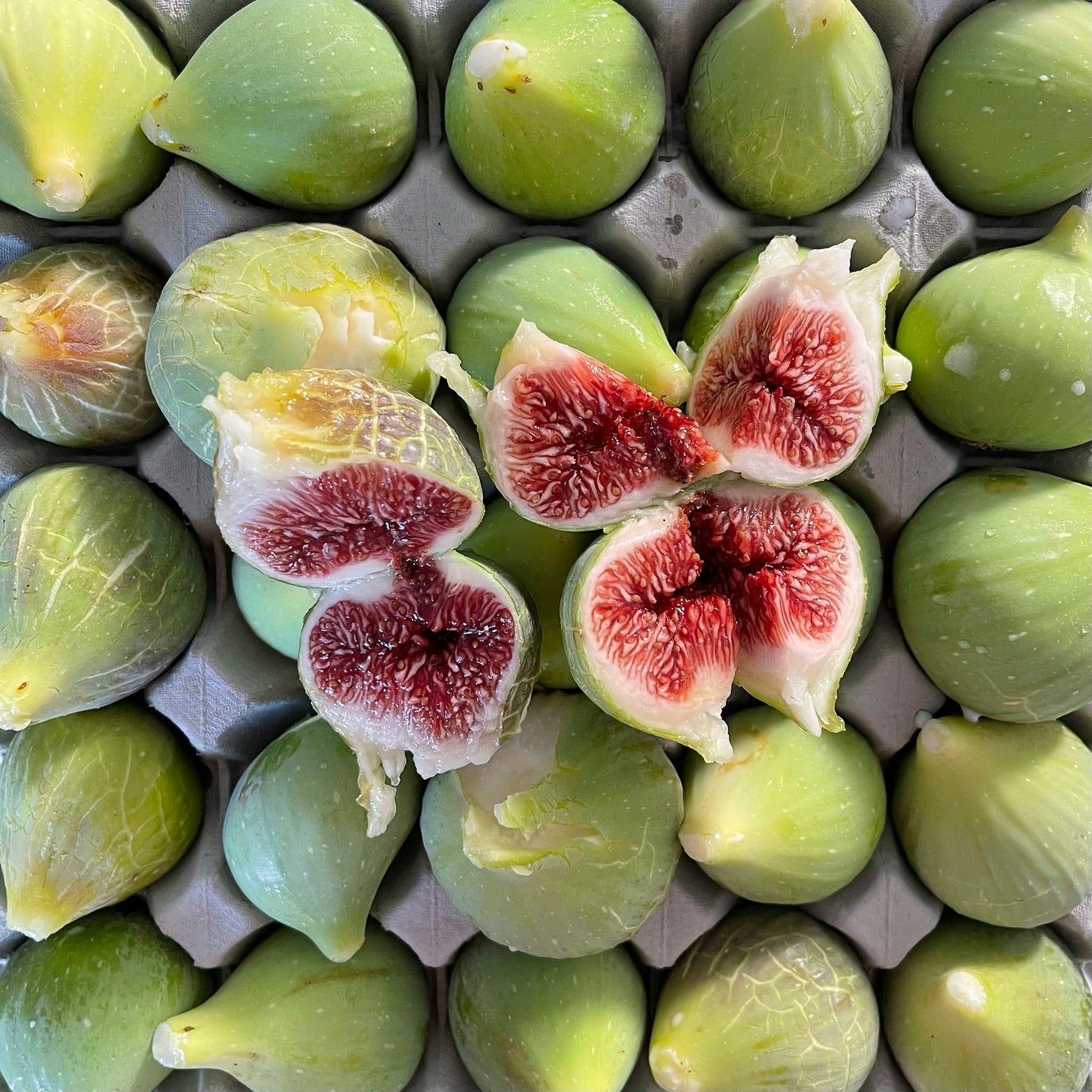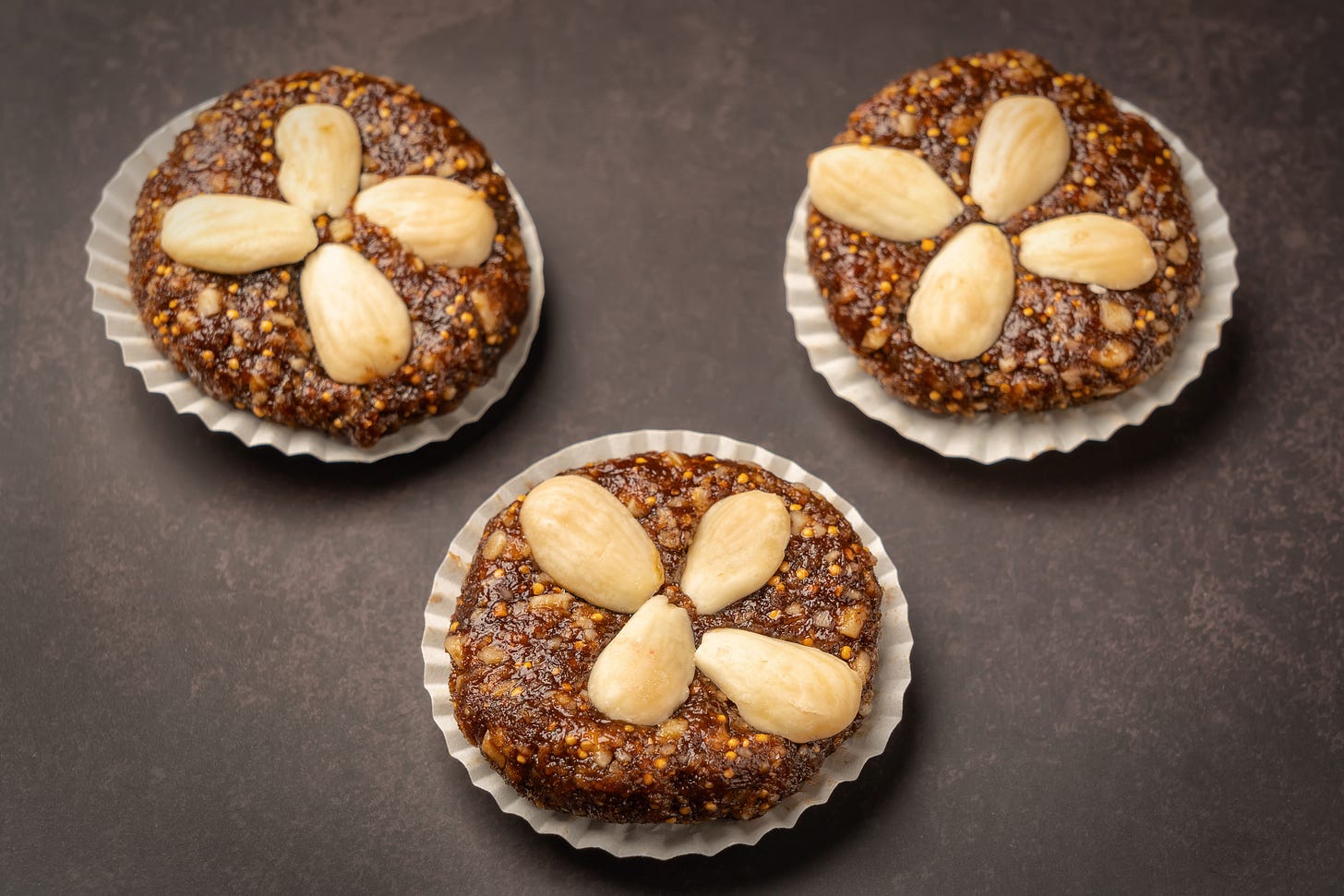Figs in Portugal: A Seasonal Journey Through Tradition and Culture
How figs shape Portugal’s seasonal rhythms and heritage.
Dear Readers,
During a visit to our local neighborhood mercado on a Saturday morning in mid-August, there was a flurry of activity going on inside the cramped little shop. As we made our way through the crowd of mostly Portuguese ladies, we noticed they were snapping up boxloads of figs - not the dried figs you see in grocery and specialty stores, but the actual green fig fruit. I knew there was a story there, so I did a little investigating.
It turns out that figs begin to appear in Portugal’s markets and gardens during the last few weeks of summer. Their plump sweetness signals the turn of the season, a reminder that the year is ripening and harvest time has arrived. For centuries, the fig has been more than just another type of fruit in Portugal. It is a marker of tradition, a symbol of abundance, and a taste that links the past with the present.
When Fig Season Begins.
Fig season in Portugal typically begins in mid-late August and continues into September, sometimes lasting into early October depending on the variety, weather conditions, and the region. In some areas, especially the Algarve where the hot, dry climate is ideal, early varieties can appear as soon as July, with a second and larger harvest coming at the end of summer. Unlike many fruits, figs do not ripen once they’ve been picked, so the best figs are eaten right off the tree.
How to Know When a Fig Is Ripe.
Color Shift: As figs ripen, their color changes—depending on the variety, this could mean turning from green to a deep brown or purple.
Touch Test: Ripe figs feel soft when gently squeezed.
Drooping Fruit: A ripe fig often hangs or droops downward on the branch.
Easy to Harvest: If a fig is ready, it should detach easily from the tree with a gentle lift.
The Fig in Portuguese Tradition.
The fig tree is deeply rooted in Portuguese culture. In rural areas, fig trees were often a family’s treasure, providing nourishment fresh, dried, or preserved through the winter months.
In the Algarve, figs have long been a cornerstone of local life. The fruit’s resilience in harsh climates, paired with the region’s almond and carob trees, formed the foundation of many traditional sweets. Over time, convent bakers transformed these simple ingredients into intricate creations, a culinary heritage that still thrives today.
The “Fig Rush” - Portuguese Ladies and Boxloads of Figs.
Obviously, in the four years I have lived in Portugal, I have not come upon the “fig rush” until this past August (there’s always something new for this immigrant to learn). Because apparently, it’s not unusual at this time of year to see Portugues ladies leaving the markets with entire boxes of fresh figs. Most of those figs are destined for something more lasting than just for snacking, and in kitchens across Portugal, the fruit is dried in the sun, transformed into thick jams, or baked into sweets.
Drying figs is especially common in the Algarve, where families spread the fruit out on woven mats or rooftops to soak up the heat. Once dried, the figs may be stuffed with almonds, dipped in chocolate, or pressed into fig “cheese” (queijo de figo), a dense, spiced cake that can be enjoyed throughout the winter. Earlier this year when visiting the Algarve, I had the chance to sample queijo de figo. It is dense and very sweet.
Other folks simmer the fruit into jam, sometimes flavored with lemon, cinnamon, or even a splash of port wine, to be paired later with Portuguese cheeses. Stocking up on figs in August is a way of ensuring that this seasonal fruit can be enjoyed for months to come, from everyday snacks to festive celebrations.
Did You Know? Traditional Fig Drying in Portugal.
In the Algarve, fig drying is an age-old practice. Families often spread freshly picked green figs on straw mats, rooftops, or stone terraces to dry naturally in the hot summer sun. The fruit is turned daily until it shrinks, sweetens, and develops a chewy texture. Once dried, figs may be split and filled with toasted almonds, lightly dusted with flour to prevent sticking, or pressed into decorative rounds. These dried figs were once an essential food supply for winter and today they’re still enjoyed as a rustic delicacy.
Figs in Festivals and Traditions.
Although there isn’t a single nationwide Portuguese festival dedicated only to figs that I could find during my research, I do know that the fruit is celebrated in many local and seasonal traditions. On St. Martin’s Day (Dia de São Martinho) in November, families gather around fires to roast chestnuts, drink new wine, and snack on dried figs and walnuts—a simple but enduring tradition that connects people to the rhythms of the land.
Beyond that, regional food festivals across Portugal often highlight figs among other seasonal treasures. The National Gastronomy Festival in Santarém, usually held in October, highlights specialties from across the country, and you’ll often find fig-based sweets among the offerings. These moments highlight how figs, while humble, remain part of Portugal’s culinary identity.
A Seasonal Treasure for Travelers.
For travelers in Portugal, fig season is one of the sweetest times of year. In late summer and early autumn, roadside stands, village markets, and even neighbors with backyard trees offer figs by the basket. They are fleeting, delicate fruits that bruise easily and must be eaten quickly, but perhaps that is part of their charm. Like the shifting season itself, figs remind us to savor the moment.
Whether you taste them fresh from the tree, sample them baked into Algarve sweets, or share dried figs around a St. Martin’s Day fire, figs offer a direct connection to Portugal’s traditions, culture, and love of simple seasonal abundance. They are more than just fruit, they are a story, a memory, and a flavor of Portugal’s soul.
Coming up Next on Our Portugal Journey…
Out and About with Carol & Paul Journey Episode 3 - Portugal Summer Vibes [Video]. Available on September 8th.
Thanks for Being on this Journey with Me!
Thank you for reading Our Portugal Journey. My newsletter is a reader-supported publication. To receive new posts and support my work, consider becoming a free or paid subscriber to help keep this publication independent.
You can also buy me a coffee or a glass of wine, anytime right here.
Also thank you to Liat M. for supporting my work through Buy Me a Coffee.
I truly appreciate it!




It reminds me of the wonderful sweet peaches of western Colorado. A sign of the end of summer.
An interesting and informative article. One of Michele's favorite fruits.